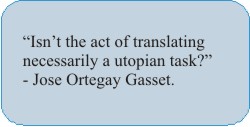Introduction
Every translator is in quest of what seems to be the unattainable, which is perfect eq uivalence. This is the undercurrent of most of the translation theories before translation studies became a well-defined field. If translation is a means of carrying over meaning from one language to another and there is no perfect correlation between them, how can there ever be an effective translation? In the 20th century, post structuralism added to the confusion by generating a lot of debate about language and its communicability. Despite all these debates there is general consensus that languages are, if not completely, to some extent mutually comprehensible. Some, like Theodore Savory would attribute it to “an equivalence of thought that lies behind its [languages'] different verbal expressions” (The Art of Translation 13). He points to the universality of certain concepts that underlie our linguistic expressions. Anton Popovic calls this translatable portion as the ‘invariant core' of literary works, an ingredient that can be salvaged in the linguistic process of translation. uivalence. This is the undercurrent of most of the translation theories before translation studies became a well-defined field. If translation is a means of carrying over meaning from one language to another and there is no perfect correlation between them, how can there ever be an effective translation? In the 20th century, post structuralism added to the confusion by generating a lot of debate about language and its communicability. Despite all these debates there is general consensus that languages are, if not completely, to some extent mutually comprehensible. Some, like Theodore Savory would attribute it to “an equivalence of thought that lies behind its [languages'] different verbal expressions” (The Art of Translation 13). He points to the universality of certain concepts that underlie our linguistic expressions. Anton Popovic calls this translatable portion as the ‘invariant core' of literary works, an ingredient that can be salvaged in the linguistic process of translation.
The choice of how to achieve equivalence ultimately rests with the translator. It depends also on how s/he interprets or reads the SL text and decides to bridge the two languages. This is why Jirí Levý defines translation as a decision-making process. The translator has to decide at each juncture what the best possible alternative would be to a particularly vexatious phrase or idiom in the SL. The example he gives is the title of the famous Brecht play, The Good Woman of Sechuan. In the original German it is Der Gute Mensch der Secuhuan, where “Mensch” can be either man or woman; the feminine ending being the only indication that it is a woman. But the title cannot be translated as such to English as English does not have a satisfactory equivalent. (“Translation as a Decision Process”, 148). The translator has to decide at this point what the best alternative could be.
. |